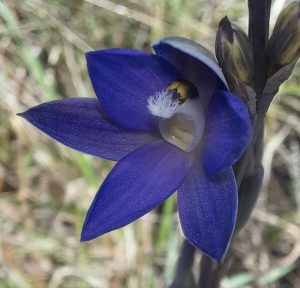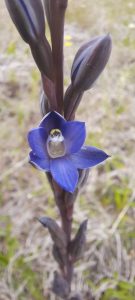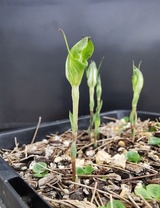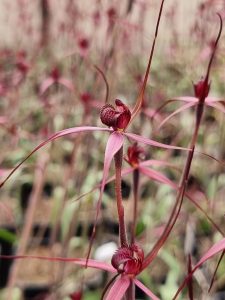At the July Sutherland group meeting, Richard Dimon presented an incredibly fascinating and very practical talk on conservation efforts and methodologies for conserving listed threatened Australian orchids.

Richard was a research assistant at the Royal Botanic Gardens, Victoria and is now undertaking a PhD and working as a technical officer at the Royal Botanic Gardens, Sydney.
Richard took us through all of the steps required to conserve and enhance populations of threatened terrestrial orchids, some of which are critically endangered and down to a few hundred individuals in the wild.
Richard showed us the enormous and very labour-intensive efforts that go on in the laboratories and nurseries of the Victorian Gardens (ex situ conservation). Steps include hand-pollination and seed collection. Hand pollination produces a 90-100% success rate of fruit and seed production. Seed is then collected where, basically, empty tea bags are placed over developing orchid capsules, in order to catch the seed. Orchid seed is, most often, very fine dust-like particles and so something suitable is needed to harvest and store it. Seed is sealed in packs and stored quickly at -20C.
Then comes the propagation. As we may know, orchid seed generally lacks endosperm; a fuel source found in most seeds, that enables the seed to germinate to the point where the plant starts to photosynthesise and create its own food. Therefore, orchids have developed very close and specific mutualistic relationships with fungi. In most cases, the orchid seed cannot germinate without the presence of the fungi which penetrates the orchid root system (mycorrhizal fungi). Richard stated that the presence of fungi results in a much better germination rate in the laboratory.
Richard collected fungi in the field – generally from within orchid populations by taking root sections (precision work!). He then had to get the root samples back to the lab within 24 hours! Often, fungal pelotons are collected which are clusters of fungi. There fungi are cultured in the lab using oatmeal agar. The main fungi cultured include the genera Serendipita and Tulasnella. Many species of these genera can associate with many different orchid genera; with a few known to be more host-specific.
Once the fungi cultures are set up, the orchid seed is then added to the fungal culture. Germination can take 3 to 9 months and sometimes up to 4 years! Orchid seedlings are then transported into a vermiculite + nutrient medium within a flask. Eventually, they go into pots and are cared for in a nursery. The nursery demands a lot of labour with hand watering and constant monitoring.

Some specific conservation efforts highlighted by Richard were for the species Thelymitra adorata (Wyong Sun Orchid), which is critically endangered in NSW. There was no success with seed germination using 5 different commercial agar-media.
Isolates of Tulasnella fungi were then used. What Richard’s team discovered, was that the time since harvesting the fungi isolate becomes crucial to orchid germination. When the fungal isolate was 12 weeks old, only 1.5% of seeds germinated. However, when it was freshly harvested (1-week old), seed germination rose to 40%! In addition, the time it took seeds to germinate also decreased. Therefore, it is now thought that fungal pelotons must be harvested, then transported to and used quickly in the lab for seed germination.
These laboratory efforts have allowed Richard to transplant cultivated orchids, back into the field and enhance natural populations. Usually, volunteers assist with the planting of the orchids, which is fantastic to hear.
Currently, more than 60 threatened orchid species across NSW, Victoria, South Australia and Western Australia are being cultivated.
Richard took us through some of his favourite case studies and orchid species that he has worked on:
Prasophyllum bagoense (Apline Leak Orchid) and P. keltonii (Kelton’s Leak Orchid) – two critically endangered orchids growing in Kosciuszko NP. Richard was able to isolate the fungi from these orchids which had not been done before.
Several species of Genoplesium and Corunastylis were symbiotically germinated for the first time.

Caladenia colorata – a critically endangered orchid found in western Victoria and South Australia with only 600-800 known plants in the wild. A total of 883 new plants were created of which 500 survived in the wild when translocated. This population is now at 1300 plants – an excellent victory for now.
Thelymitra epipactoides (Metallic Sun Orchid) which is presumed extinct in NSW but grows in other states.
Pterostylis hians (Opera House Greenhood).
Diuris fragrantissima (Fragrant Doubletail) – critically endangered in southern Victoria
D. callitrophilla (Oaklands Diuris) – endangered in NSW and for which 2000 plants have been cultivated and are to be planted in the wild.

There are a lot of other threatened Caladenia orchids with C. rosella, C. xanthochila, C. gladiolata (smelling like burnt rubber), C. fulva, C. arenaria, C. cretacea (for which 200 have been planted), C. cruciformis, C. audasii and C. pumila all worked on. For Caladenia audasii (Audas Spider Orchid), only 15 plants are known to be in existence in the wild in Victoria.
A very good web video is here where Richard makes an appearance.
Richard’s research will continue into areas such as monitoring the success of planted orchids into the field; along with pollination and ecological research including those special traits that orchid flowers possess such as mimicry, sexual deception and brood- site mimicry. Further planting episodes of threatened orchids are planned to augment critically endangered populations. Richard’s research certainly appears to be putting conservation runs on the board.
A public display of orchids can be viewed at the Royal Botanic Gardens, Victoria.
